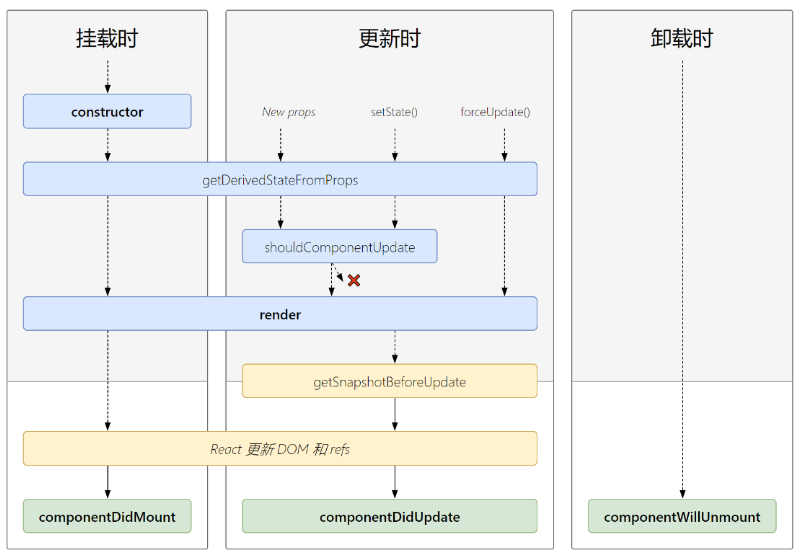1. 旧版本的声明周期
1. 原理解析
初始化阶段: 由ReactDOM.render()触发初次渲染
- constructor()
- componentWillMount()
- render()
- componentDidMount() =====> 常用
更新阶段,由组件内部this.setSate()或父组件render触发
- componentWillReceiveProps(),父组件第一次render不触发,第二次及之后render()时才会触发
- shouldComponentUpdate()
- componentWillUpdate()
- render() =====> 必须使用的一个
- componentDidUpdate()
- 若执行shouldComponentUpdate方法返回true时可以正常继续下面的流程
- 若shouldComponentUpdate方法返回false时则返回,不执行后面的流程
- 强制更新时会跳过shouldComponentUpdate()
卸载阶段,由ReactDOM.unmountComponentAtNode()触发
- componentWillUnmount() =====> 常用
2. 原理图

2. 新版本声明周期
删除了componentWillMount(),componentWillReceiveProps(), componentWillUpdate()
1. getDerivedStateFromProps
- 必须用static修饰
- 若state的值在任何时候都取决于props,那么可以使用getDerivedStateFromProps
- 接收两个参数,props和state
- 若返回值不为null,则将返回值和state进行合并
2. getSnapshotBeforeUpdate
- 该方法的返回值作为参数传递给componentDidUpdate,即下面的snapshotValue
- componentDidUpdate(preProps,preState,snapshotValue)
3. 原理解析
初始化阶段: 由ReactDOM.render()触发初次渲染
- constructor()
- getDerivedStateFromProps()
- render()
- componentDidMount() =====> 常用
更新阶段,由组件内部this.setSate()或父组件render触发
- getDerivedStateFromProps()
- shouldComponentUpdate()
- render() =====> 必须使用的一个
- getSnapshotBeforeUpdate()
- componentDidUpdate()
- 若执行shouldComponentUpdate方法返回true时可以正常继续下面的流程
- 若shouldComponentUpdate方法返回false时则返回,不执行后面的流程
- 强制更新时会跳过shouldComponentUpdate()
卸载阶段,由ReactDOM.unmountComponentAtNode()触发
- componentWillUnmount() =====> 常用
2. 原理图
